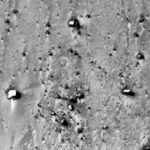NASA Photos Show Utah Monolith On Mars, Martian Moon Phobos0
- From Around the Web, Space
- December 9, 2020
Monoliths on Phobos, Mars and the Utah Desert, May All Be Related Structures

Monoliths on Phobos, Mars and the Utah Desert, May All Be Related Structures

The Japanese agency’s sample return mission will explore the origin of Mars’ curious moons.

On April 24, 2019, NASA’s Mars Odyssey orbiter captured a new thermal image of Phobos, the larger of Mars’ two moons. Each color in the full-moon image represents a temperature range detected by Odyssey’s Thermal Emission Imaging System (THEMIS) camera.

Scientists have struggled for decades to explain how the two tiny moons of Mars came to be, but a new study relying on old data bolsters one of the two major hypotheses.

NASA’s longest-lived mission to Mars has gained its first look at the Martian moon Phobos, pursuing a deeper understanding by examining it in infrared wavelengths.

While many other space missions are interested in Mars, The Japanese Aerospace Exploration Agency (JAXA) is planning to investigate Phobos and Deimos.

It’s possible that Mars had rings at one point and may have them again someday.

NASA’s MAVEN spacecraft performed a previously unscheduled maneuver this week to avoid a collision in the near future with Mars’ moon Phobos.

The moon orbiting over Mars, Phobos, is slowly falling towards the surface of the red planet.

Crisscrossed grooves and chains of small craters cover the Martian moon Phobos. Astronomers have disagreed about what caused this strange-looking landscape for decades, but new research may help settle the debate.